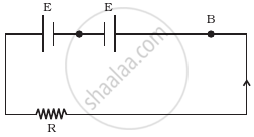Advertisements
Advertisements
प्रश्न
Two cells of same emf E but internal resistance r1 and r2 are connected in series to an external resistor R (Figure). What should be the value of R so that the potential difference across the terminals of the first cell becomes zero.
उत्तर
In this problem first we apply Ohm' law to find current in the circuit.
Effective emf of two cells = E + E = 2E
Effective resistance = R + r1 + r2
So the electric current is given by
`I = (E + E)/(R + r_1 + r_2)`
`V_1 = E - Ir_1 = E - (2E.r_1)/(R + r_1 + r_2)`
The net potential difference across 1st cell V1 = 0 (Given)
∴ `E - (2Er_1)/(R + r_1 + r_2)` = 0
Or `1 - (2r_1)/(R + r_1 + r_2)` = 0
`(2r_1)/(r_1 + r_2 + R) = 1/1`
Or 2r1 = r1 + r2 + R
| r1 – r2 = R |
It is the required condition for the potential difference across 1st cell to be zero.
APPEARS IN
संबंधित प्रश्न
Write the formula of resistivity
The graph between V and I for a conductor is a straight line passing through the origin.
What should remain constant in a statement of this law?
Tick(✓) the correct choice in the following:
Ohm's law is applicable to
- Name and state the law which relates the potential difference and current in a conductor.
- What is the necessary condition for a conductor to obey the law named above in part (a) ?
Answer the following question.
Distinguish between Ohmic and non-ohmic substances; explain with the help of example.
A wire connected to a power supply of 230 V has power dissipation P1. Suppose the wire is cut into two equal pieces and connected parallel to the same power supply. In this case, power dissipation is P2. The ratio of `"P"_2/"P"_1` is
The resistance of a nichrome wire at 0°C is 10Ω. If its temperature coefficient of resistivity of nichrome is 0.004/ °C, find its resistance of the wire at boiling point of water. Comment on the result.
State Ohm’s law? How can it be verified experimentally? Does it hold good under all conditions? Comment.
Suppose there is a circuit consisting of only resistances and batteries and we have to double (or increase it to n-times) all voltages and all resistances. Show that currents are unaltered. Do this for circuit of Example 3.7 in the NCERT Text Book for Class XII.
Why should an ammeter have low resistance?
